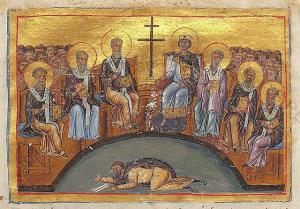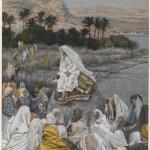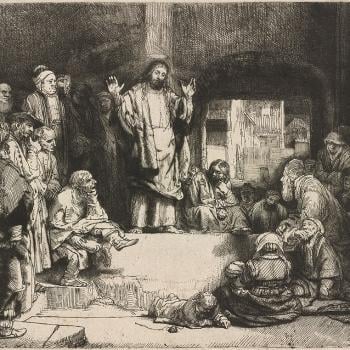
The truths of the Christian faith have practical implications which follow from them. The teaching of II Nicea, the Seventh Ecumenical Council, concerning the validity of images represents one such implication. It explores how the incarnation demonstrates that we can use images to represent our faith. God, in the incarnation, assumed not just a generic human nature, but became a particular man, Jesus. As every person is not some nebulous, unimaginable blob, but rather, has an imaginable form, so Jesus comes to us with his own image, an image which imagines who and what he is, not just as man, but as God. The invisible God has become visible, through a human form, while remaining invisible and transcendent in accordance to the divine nature.
We are led to God through God’s employment of a human image. God uses images. That’s one practical implication of the incarnation. We can and should honor what God has done, and all that relates to God’s activity in the world. This is why, not only can we can use images to represent divine truths, we can also honor God through them. We can venerate images which represent Jesus, but we can also venerate images portraying events connected with him and his life, and the people involved in them. Similarly, we can venerate the saints through images because holiness is the product of God’s gracious work in their lives. All who are made holy are made holy by Christ, and so are connected to him. They are his, and all that is his can be used to glorify him, as Jesus said in his words to the Father: “all mine are thine, and thine are mine, and I am glorified in them” (Jn. 17:10 RSV).
II Nicea tells us we can (and should) use images to connect us to God, because God has used them. They serve as pointers transcendent truth. That is, God helps us relate to the incomprehensible truth through them, for God has provided us a relative means by which we can apprehend and ascertain the absolute truth, a means which uses our senses because we rely upon them to apprehend the truth for ourselves.
The theological reasonings used to promote the use of images have practical consequences for us beyond the promotion of holy images. They suggest we can use the world and what is in it as a means to honor God. Material creation was taken up by God in the incarnation, and now should be honored and protected, because God has sanctified it and made it holy. We should also keep in mind how humanity possesses the image and likeness of God in it, meaning, when we help each other, especially the least among us, showing each other dignity and respect, we are honoring God. We show our love for God by loving our neighbor. And, if it means, we must sacrifice something of ourselves for the sake of our neighbor, it is that kind of sacrifice, the sacrifice of love, which God wants from us: “Do not neglect to do good and to share what you have, for such sacrifices are pleasing to God” Heb. 13:16 RSV). Because God assumed material creation and made it a means by which divine glory can be experienced, it is not idolatry to honor and respect anyone and anything existing in it.
Thus, the theology of II Nicea presents to us one of the practical implications which we can and should discern when we reflect upon the truth of the incarnation. We can and should embrace the use of images, because it is what God did when God become man. The invisible, incomprehensible God, has established a way for us to engage the divine nature with our senses. This has opened us up to truly using our whole being, including our senses, in our worship of God. Nonetheless, God’s embrace of images followed God’s kenotic embrace of self-sacrificial love, and so our engagement with images should lead us to follow that example. We should give ourselves to those in need, to the least among us, to those who are otherwise seen as described as “outsiders” or impure sinners, because when we ourselves were “outsiders” of the kingdom of God, when we were but sinners, God came to us and showed us that love. We might be derided by the so-called holy men and women of God, those who proclaim their own glory, their own worthiness to others, but it should not detour us, for that is what Jesus experienced. When our love is pure, we should be willing to embrace him and share in solidarity with him the abuse which he suffered: “So Jesus also suffered outside the gate in order to sanctify the people through his own blood. Therefore let us go forth to him outside the camp and bear the abuse he endured” (Heb. 13:12-13 RSV).
II Nicea is truly an important council. It shows us that we must not neglect the practical implications of the incarnation. Our faith is meant to be one which is lived and not one which is merely resides in our thoughts and prayer. We cannot follow a Gnostic rejection of the world, but rather, we embrace the world like God did. We must share with it the grace God has given to us. In this way, we will bring to fruition the Lord’s Prayer, making sure God is glorified in the world even as God is glorified in heaven. We see the beginnings of this in and through the saints, whose lives, to be sure, were often riddled with sin, darkened by terrible deeds. Dark clouds of sins can overshadow them, but they cannot overtake the radiance of grace; when we look at them and what they achieved, we can see that God, despite their sins, accomplished many great deeds for the world, and this is what we honor when we honor them and their lives. If God can work in them, despite how terrible their sins might have been, we have reason to hope God can work in others, including ourselves. For we know, despite however dark the clouds of sin, the darkness cannot overcome the light: the darkness has been defeated, and the glorification of the saints is but a representation of this truth. The good, wherever it is found, can be filled with grace, grace, which as it builds up, becomes as it were a light, so that in the end, there will be no darkness left, that is, God will truly be all in all.
Stay in touch! Like A Little Bit of Nothing on Facebook.
If you liked what you read, please consider sharing it with your friends and family!
N.B.: While I read comments to moderate them, I rarely respond to them. If I don’t respond to your comment directly, don’t assume I am unthankful for it. I appreciate it. But I want readers to feel free to ask questions, and hopefully, dialogue with each other. I have shared what I wanted to say, though some responses will get a brief reply by me, or, if I find it interesting and something I can engage fully, as the foundation for another post. I have had many posts inspired or improved upon thanks to my readers.












